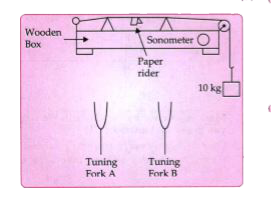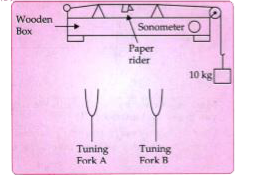
The diagram above shows a wire stretched over a sonometer. Stems of two vibrating tuning forks A and B are touched to the wooden box of the sonometer. It is observed that the paper rider (a small piece of paper folded at the centre) present on the wire flies off when the stem of vibrating tuning fork B is touched to the wooden box but the paper just vibrates when the stem of vibrating tuning fork A is touched to the wooden box.
Why does the paper rider fly off when the stem of tuning fork B is touched to the box ?
The frequency of tuning fork B is equal to the natural frequency of wire, so the wire vibrates with a large amplitude and rider flies off
Topper's Solved these Questions
Similar Questions

The diagram above shows a wire stretched over a sonometer. Stems of two vibrating tuning forks A and B are touched to the wooden box of the sonometer. It is observed that the paper rider (a small piece of paper folded at the centre) present on the wire flies off when the stem of vibrating tuning fork B is touched to the wooden box but the paper just vibrates when the stem of vibrating tuning fork A is touched to the wooden box.
Name the phenomenon when the paper rider flies off.
View SolutionThe diagram below shows a wire stretched over a sonometer. Stems of two vibrating tuning forks A and B are touched in turn to the wooden box of the sonometer. It is observed that the paper rider (a small piece of paper folded at the centre) present on the wire flies off when the stem of vibrating tuning fork B is touched to the wooden box but the paper just vibrates when the stem of vibrating tuning fork A is touched to the wooden box.

Name the phenomenon when the paper rider just vibrates.
View SolutionName the phenomenon that cause a loud sound when the stem of a vibration tuning fork is kept pressed on the surface of a table.
View SolutionWhen the stem of a vibrating tuning fork is gently pressed on the surface of a table louder sound is heard. Why?
View SolutionA wire is stretched between two bridges A and B. A small piece of paper of shape A (called rider) is placed at the middle of the wire. When the stem of a tuning fork P is placed at the bridge A the rider only vibrates, but it flies away when another tuning fork Q is placed. Explain the difference.
View SolutionThe stem of a vibrating tuning fork is pressed against a table top.
Will it produce an audible sound ?
View SolutionDraw diagrams to show the loop formation in a vibrating tuning fork.
View SolutionThe stem of a vibrating tuning fork is pressed against a table top.
Does it cause the table top to set in vibrations ? If yes, what type of vibrations are they?
View SolutionThe stem of a vibrating tuning fork is pressed against a table top.
Under what condition does it lead to resonance ?
View SolutionWhen a vibrating tuning fork is placed on a sound box of a sonometer, 8 beats per second are heard when the length of the sonometer wire is kept at 101cm or 100cm. Then the frequency of the tuning frok is (consider that the tension in the wire is kept constant)
View Solution
